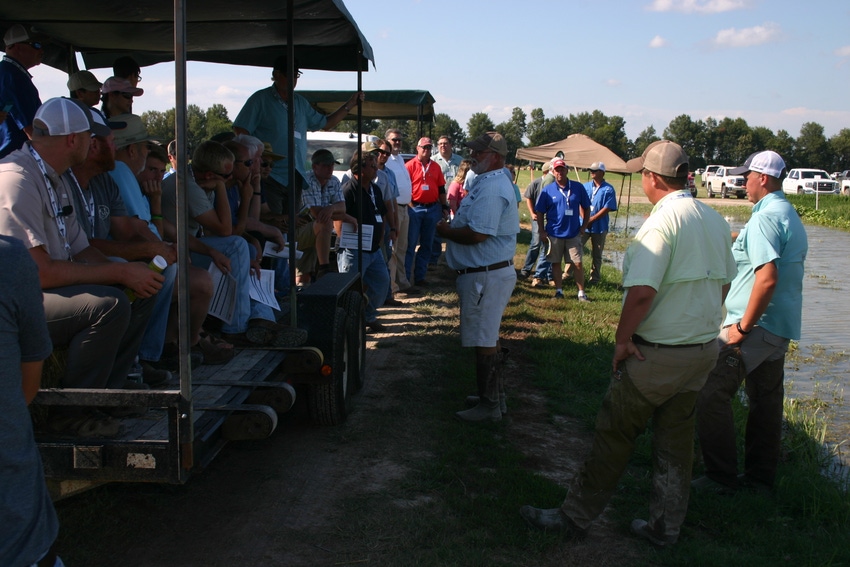
In early August, alongside seed treatment rice research plots, Gus Lorenz spoke to several trailers full of Ricetec field day attendees about pest problems he’s seen in 2017. The Arkansas Extension entomologist says “grape colaspis really hurt a lot of farmers this year. Many who didn’t have a neonic seed treatment were hit. We saw this in our research plots, we saw it across the state in growers fields where there has been severe stand injury and ultimately they’ll lose yield.”
The seed treatment research just south of Jonesboro, Ark., “is trying to get that early grape colaspis control and then stretch out to gain rice water weevil control when you finally get a flood on the field. We’ve had this same trial duplicated at several locations.”
What Lorenz and colleagues found is “the neonic stood tall and gave us the protection we wanted. We planted about March 29 and finally put the flood on 68 days later.”
Then rice water weevils moved in and “we’re sampling and finding – in our untreated checks and neonic seed treatments – about 40 per core. In a 4-inch core we’re finding 40 rice water weevil larvae feeding on the roots. The threshold is about three.
“Hopefully, we’ll be able to identify the rates that’ll take care of this. It’s got to be cost-effective for the grower. If we can’t get both seed treatments on be cost-effective, we’ll have to look somewhere else.”
Scouting/sweeping
Aaron Cato, a graduate student working with Lorenz, picks up the narrative. “Rice stink bug comes in about when the panicle begins to emerge from the boot. The threshold is five per 10 sweeps for the first two weeks and then 10 per 10 sweeps after that.
“This year, we experienced a large flight of stink bugs coming in right when the rice began heading. They came out of native grasses near rice fields and that led to a lot of applications of Lambda or Cyhalothrin.”
The following two weeks, “we found that when an application wasn’t made early – and many people didn’t make that spray – there was a combination of both nymphs and adults in the field. Research shows that a large nymph will do just as much damage to the kernel as an adult. The reason for that is the damage isn’t due to a yield loss but a quality loss. They’re penetrating the husk and kernel allowing fungi and bacteria in, which can cause peck. Peck can also happen due to bad weather and other factors.
“We have a trial here where we’re spraying different plots under different thresholds. We have the (aforementioned) 5-for-10 in the first two weeks and 10-for-10 after that. Then, we have a plot that doubles those thresholds. Another is at 10-for-10 the entire time; another is at 20-for-10 the entire time.”
One word of caution when combatting the insects: know how to properly sweep for them.
“We’re doing the trial because although many of you own sweep nets you don’t sweep exactly like we do,” says Cato. “We recommend a 15-inch sweep net. In soybean, you have to dig down when you sweep to get the stink bugs, greens and browns, and bollworms. In rice, you want to sweep the rice head – you want the rice head to be in the center. Sweep with the net out in front of you a bit and about 3.5- to 4-foot high, depending on the variety.”
Latter stages warning
Lorenz says as the rice crop moves to its latter stages there are several things to watch for. “Now that we have more and more rice heading, the numbers of rice stink bugs are actually going down in some fields. We’re seeing the stink bugs dispersing. But this is the calm before the storm because the late-planted rice is coming along and will be out in the next several weeks. We’ll see tremendous numbers in that late-planted crop.
“That’s why we say, when it comes to rice and rice stink bugs, you don’t want to be first and you don’t want to be last. If you’re a grower with late-planted rice this year, you really need to be on point.
“There’s really only a four-week period when you have to worry about rice stink bugs. Be diligent during that timeframe you’ll be okay. If you don’t take care of business, though, you can see significant yield loss.”
After looking at control options “it’s hard for me to get off the $1.5 shot of Lambda,” says Lorenz. “I can get good control with that product, or Mustang Max. There are other products that provide good control but they cost a lot more and the residual control isn’t that much better. I’m better off sticking with the cheap stuff and then following up, particularly on the late-planted rice.”
How much better control do you get with 10 gallons of water per acre compared to five?
“It’s not just in rice but other crops – coverage is critical,” says Lorenz. “If you don’t get good coverage, you don’t get good control…
“When it’s 95 to 105 degrees and you’re putting it out at two gallons of water in the heat of the day, what level of control do you really expect? I don’t care if I’m spending $1.5 or $20 for a product, I’m going to make sure I get a good application. If it takes 10 gallons, that’s fine. Most of the time, five gallons is adequate.”
About the Author(s)
You May Also Like




